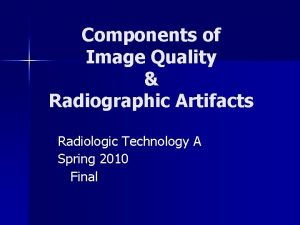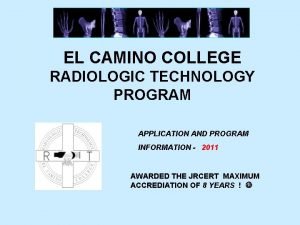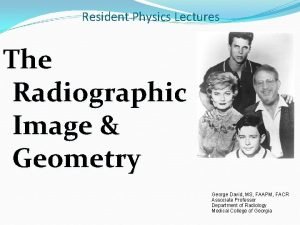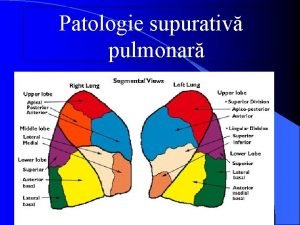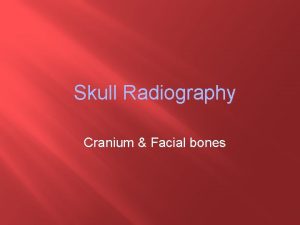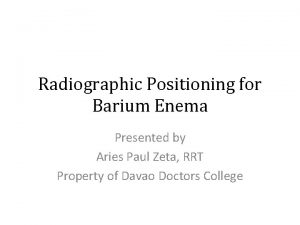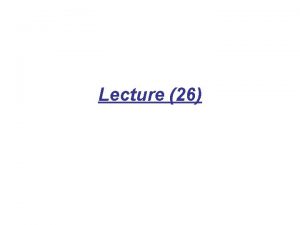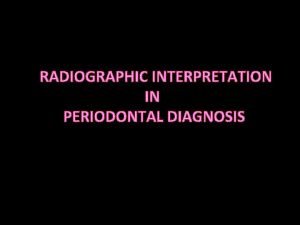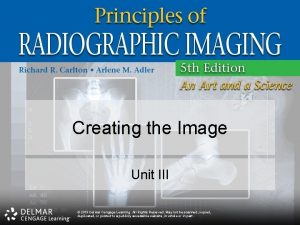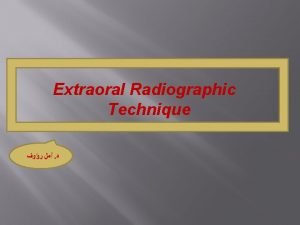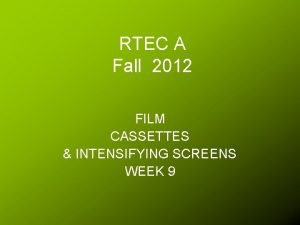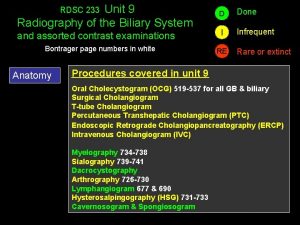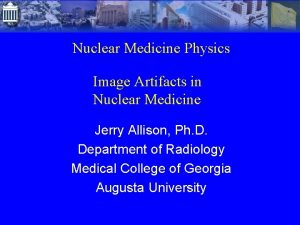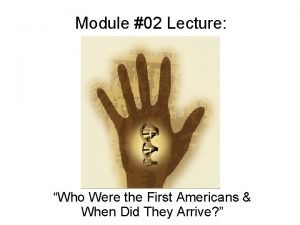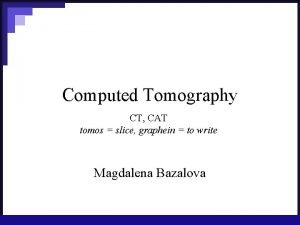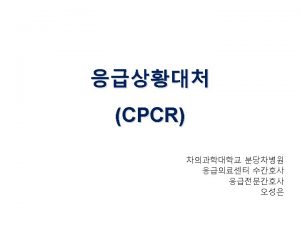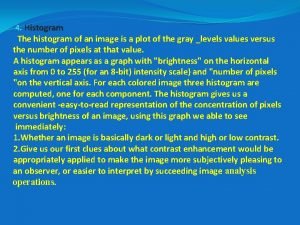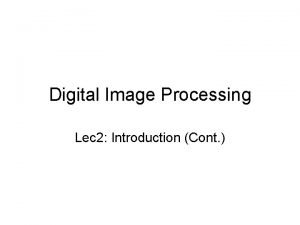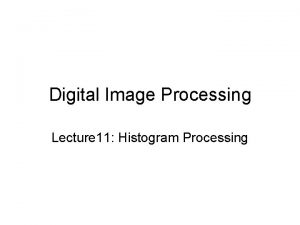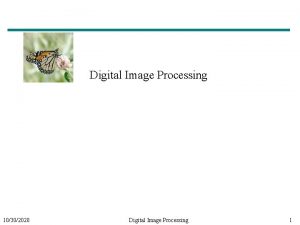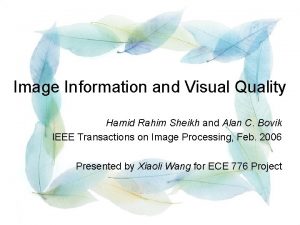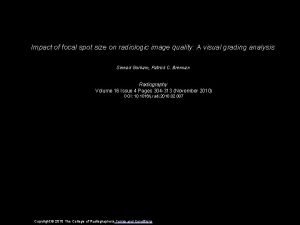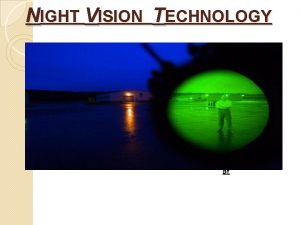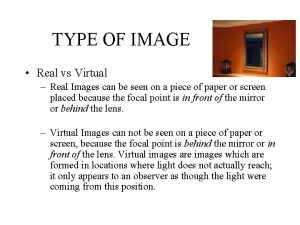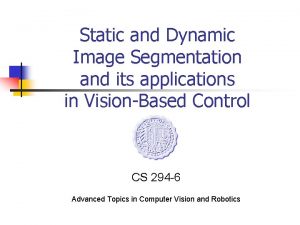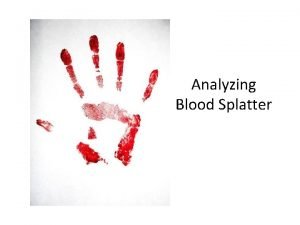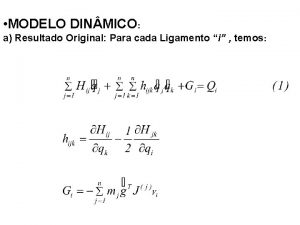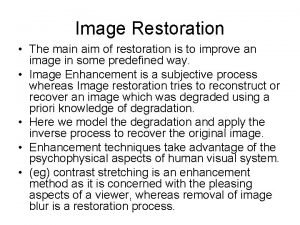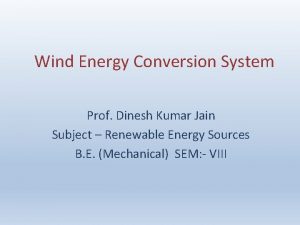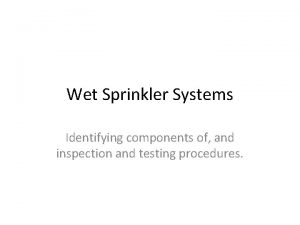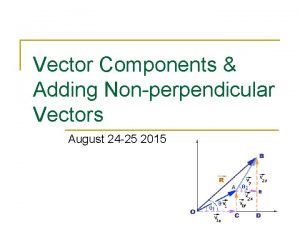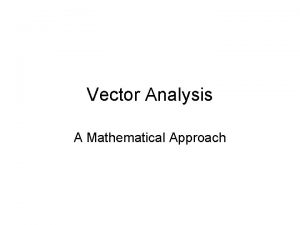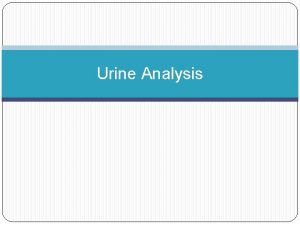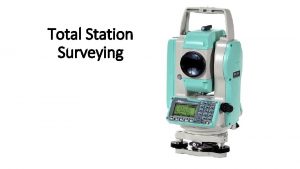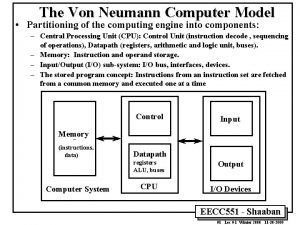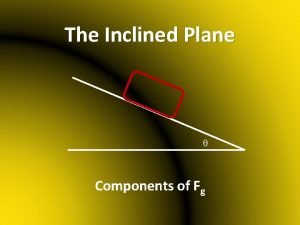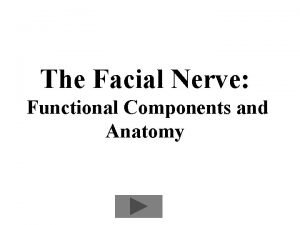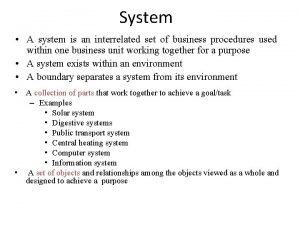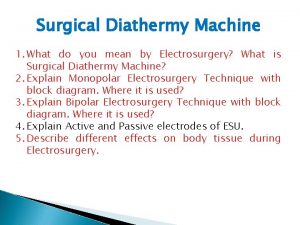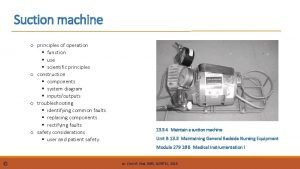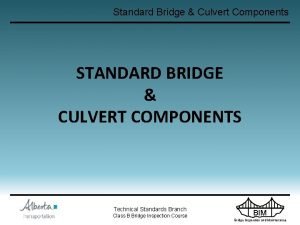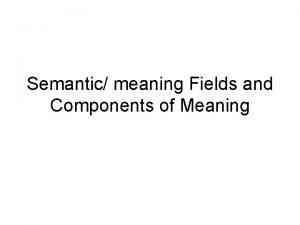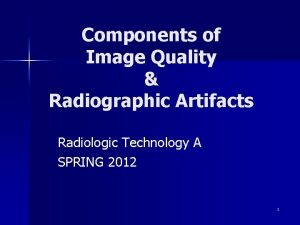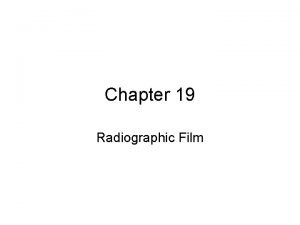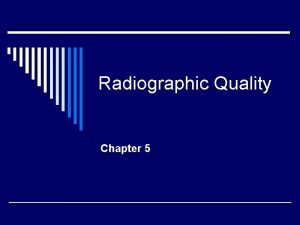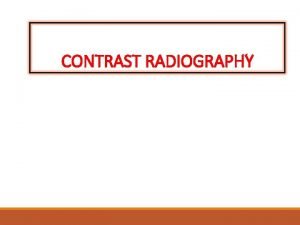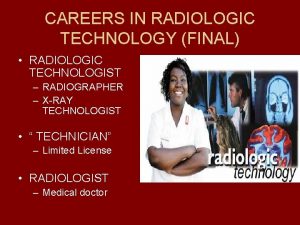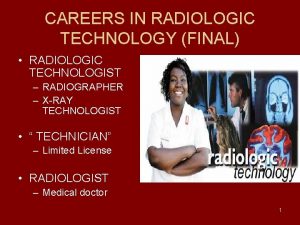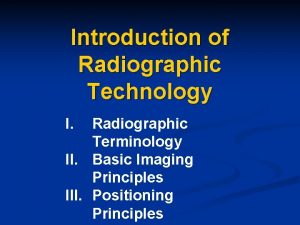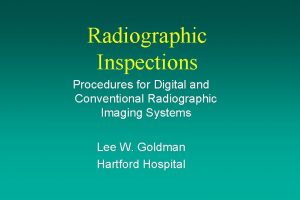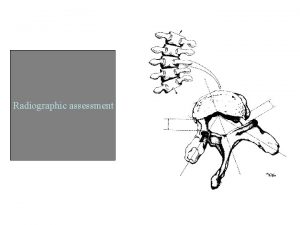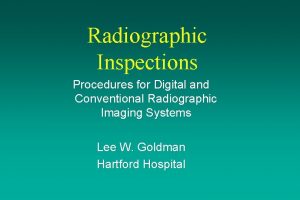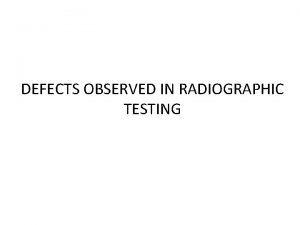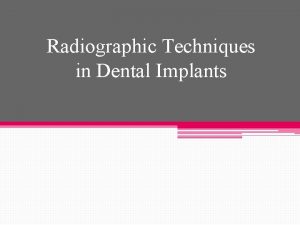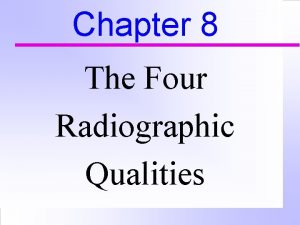Components of Image Quality Radiographic Artifacts Radiologic Technology
































































































































































- Slides: 160

Components of Image Quality & Radiographic Artifacts Radiologic Technology A Spring 2010 Final

n X-ray Exposure Factors n Radiographic Density & Contrast n Components of Image Quality n Radiographic Artifacts

Review Chapter 7 n Primary radiation exits the tube n Interacts with various densities in the body n Photons may be absorbed n Scattered n Passed through without any interference to the cassette or image receptor (IR)


How well we can see something on the image

Image detail is affected by:

Photographic Properties 1 2

X-ray Exposure Factors TECHNIQUE SELECTION: n Radiographer selects the n Kilovoltage peak (k. Vp) n Milliamperage (m. A) & time (s) n Milliamperage x time = m. As (milliamperage multiplied by a set time measured in seconds) n

Kilovoltage Peak n k. Vp n One kilovolt = 1000 volts n The amount of voltage selected for the x-ray tube. n Range n k. Vp 30 to 150 k. Vp controls _____ ?

Milliamperage n One milliampere (m. A) = one thousandth of an ampere. n The amount of current supplied to the xray tube n How many x-rays will be produced n Range 10 to 1200 m. A

Time n In seconds n How long x-rays will be produced n 0. 001 to 6 seconds

Milliampere Seconds n Technologists think in terms of m. As n Calculated by m. A x seconds n Ex: 100 m. A X 0. 2 s = 20 m. As n How many x-rays will be produced and for how long. n Modern x-ray machines only allow control of n m. As controls ________ ?

Factors Affecting Density n Primary control factor: n Influencing factors:

Primary Controlling Factor of Density 1. m. As 2. m. A = AMOUNT of electrons sent across the tube combined with TIME (S) = m. As 3. m. As controls DENSITY on radiograph primary function of m. As is DENSITY

Imagine this… n If the m. A station is changed from 200 to 400 m. A, twice as many electrons will flow from the cathode to the anode. n From 10 m. A to 1000 m. A = 100 x more n m. A controls how many electrons are coming at the target n m. As is a combination of how many and for how long (seconds)

10 m. A 1000 m. A


Changing Mas – Changes Density + 25 % + 50 % mas

Influencing Factor on Density:

k. Vp more energy = more photons passing though tissue & striking the image ______ = doubling of exposure to the film _______ = halving of exposure to the film á _____ rule will also change the contrast of the image because k. V is the primary method of changing image contrast. Remember : ___ change ( ) KVP has the same effect as doubling or ½ the MAS on density

Change in k. Vp controls the energy level of the electrons and subsequently the energy of the x-ray photons. n A change from 72 k. Vp will produce x-rays with a lower energy than at 82 k. Vp n Difference between a ball traveling 72 mph and 82 mph (how much energy did it take to throw the ball at the rates? )

+ 15% kvp - 15% kvp

Radiolucent vs. Radiopaque n ______ materials allow x-ray photons to pass through easily (soft tissue). n _____ materials are not easily penetrated by xrays (bones)

Creating the Image n Transmission (no interaction) – Responsible for dark areas n Scatter (grays) – produces no diagnostic info n Absorption (photoelectric effect) – Responsible for light areas

Images n ______ = THE AMOUNT OF BLACKENING “DARKNESS” ON THE RADIOGRAPH (m. As) n ______ – THE DIFFERENCES BETWEEN THE BLACKS TO THE WHITES (k. Vp)

Why you see what you see… n The films or images have different levels of density – different shades of gray n X-rays show different features of the body in various shades of gray. n The gray is darkest in those areas that do not absorb X-rays well – and allow it to pass through n The images are lighter in dense areas (like bones) that absorb more of the X-rays.

Image Production _______ – The beam of photons, B 4 it interacts with the pt’s body. n _______ – The resulting beam that is able to exit from the patient. n _______ – Radiation that interacts with matter & only continues in a different direction – not useful for image production. n _______ – Primary radiation that is changed (partially absorbed) as it travels through the pt. n

Patient Body Size and Pathology

3 Different Body Habitus Hypersthenic Sthenic Hyposthenic Dr. Charman, Eric Guzman, Adam Guzman Thank you to the 3 men in my life ! DCharman






Density and Images

Goal: Producing optimal radiographs DENSITY Too dark Too light


Controlling Factor of Contrast

Controlling Factor of Contrast n Kilovolts to anode side – k. Vp n Kilovolts controls how fast the electrons are sent across the tube n _______ – controls CONTRAST on images

Producing optimal radiographs Contrast Scale Long scale short scale


Scale of Contrast? Which one is “better” How does the k. Vp affect these images?



Short Scale vs. Long Scale


Beam Restriction and Grids

Scatter – Creates fog – Lowers contrast (more grays) n Increases as:

Effects of collimation (beam restriction) on scatter

n Collimate to area of interest reduces scatter and radiation dose to the patient

Grids n A device with lead strips that is placed between the patient and the cassette n Used on larger body parts to reduce the number of scattering photons from reaching the image

GRID NO GRID CONTROLS CONTRAST

Basic Grid Construction 1. Radiopaque lead strips 2. Separated by radiolucent interspace material - Typically aluminum 3. Allow primary radiation to reach the image receptor (IR) 4. Absorb most scattered radiation 5. Primary disadvantage of grid use 1. Grid lines on film

GRIDS

Grid is placed between patient (behind table or upright bucky) & cassette

Grids absorb scatter – prevents it from reaching the image GRID STOPS SCATTER


With Grid No Grid


GEOMETRIC Properties n Recorded Detail n DISTORTION – _______ n Magnification – _______ n Elongation n Foreshortening

RECORDED DETAIL

RECORDED DETAIL n The degree of sharpness in an object’s borders and structural details. n How “clear” the object looks on the radiograph

Recorded Detail n The degree of sharpness in an object’s borders and structural details. n Other names: 1. 2. 3. 4.

RESOLUTION TEST TOOLS LINE PAIRS/ MM Depicts how well you can see the differences in structures More lines=more detail


Factors that affect Recorded Detail 1. 2. 3. 4. 5. 6. 7. Geometric unsharpness OID SIZE SHAPE Motion unsharpness (blurring) Intensifying Screens Film Speed / Composition Film – Screen contact Kvp & Mas (density / visibility)


MOTION AKA Blurring

Motion n Can be voluntary or _______ n Best controlled by short exposure times n Use of careful ________ to the pt. n Suspension of pt. respiration n ___________ devices


Decrease Motion Unsharpness n Instruct patient not to move or breath n Use Immobilization devices n Use Short exposure times n Lock equipment in place



Object Unsharpness n Main problem is trying to image a 3 -D object on a 2 -D film. n Human body is not straight edges and sharp angles. n We must compensate for object unsharpness with factors we can control: focal spot size, SID & OID

SID Source to Image Distance n The greater the source X-ray tube) to image (cassette) distance, the greater the image sharpness. n Standard distance = 40 in. most exams n Exception = Chest radiography 72 in.


SID n Shine a flashlight on a 3 -D object, shadow borders will appear “fuzzy” -On a radiograph called Penumbra n Penumbra (fuzziness) obscures true border – umbra n Farther the flashlight from object = sharper borders. Same with radiography.


OID Object to Image Distance n The closer the object to the film, the sharper the detail. n OID , penumbra , sharpness n n Structures located deep in the body, radiographer must know how to position to get the object closest to the film.

The position of the structure in the body will influence how magnified it will be seen on the image The farther away – the more magnified


Distortion n Misrepresentation of the true size or shape of an object – ________ – size distortion – ________ – shape distortion

MAGNIFICATION n TUBE CLOSE TO THE PART (SID) n PART FAR FROM THE CASSETTE (OID)


n http: //www. coursewareobjects. com/ob jects/mroimaging_v 1/mod 04 i/0416 a. ht m

Size Distortion & OID n If source is kept constant, OID will affect magnification n As OID , magnification n The farther the object is from the film, the more magnification


• In terms of recorded detail and magnification the best image is produced with a • ______ OID & _____ SID

Minimal magnification small OID Magnification large OID

Size Distortion & SID n Major influences: SID & OID n As SID , magnification n Standardized SID’s allow radiologist to assume certain amt. of magnification factors are present n Must note deviations from standard SID






SHAPE DISTORTION Elongation and Foreshortening

Shape Distortion n Misrepresentation of the shape of an object n Controlled by alignment of the beam, part (object), & image receptor n Influences: Central ray angulation & body part rotation



Image Distortion n When the part to be imaged – does not lay parallel with the IR (cassette) n If the Central Ray is not perpendicular to the part – CR should be at right angle with the cassette

Central Ray Angulation n Body parts are not always 90 degrees from one another n Central ray angulation is used to demonstrate certain details that can be hidden by superimposed body parts. n Body part rotation or obliquing the body can also help visualize superimposed anatomy.

Central Ray n Radiation beam diverges from the tube in a pyramid shape. n Photons in the center travel along a straight line – central ray n Photons along the beam’s periphery travel at an angle n When central ray in angled, image shape is distorted.








Focal Spot Size n Smaller x-ray beam width will produce a sharper image. n Fine detail = small focal spot (i. e. small bones) n General radiography uses large focal spot n Beam from penlight size flashlight vs. flood light beam

ANODE


FOCAL SPOT ANGLE SMALLER ANGLE – SMALLER BEAM AT PATIENT

http: //www. xray 2000. co. uk/

Artifacts - Types n Processing Artifacts n Exposure Artifacts n Handling & Storage Artifacts

Processing Artifacts Emulsion pickoff n Chemical fog n Guide-shoe marks n Water marks n Chemical spots n Guide-shoe & roller scratches n





Exposure Artifacts Motion n Improper patient position n Wrong screen-film match n Poor film/screen contact n Double exposure n Warped cassette n Improper grid position n

Artifact




Handling & Storage Artifacts Light fog n Radiation fog n Static n Kink marks n Scratches n Dirty cassettes n


















Pt clothing




PATHOLOGY NOT ARTIFACT

Name & cause of this?










Evaluating Images What do you think?

n n n Does this show good detail? Is all of the anatomy present? How is the density / contrast?
 Radiation fog artifact
Radiation fog artifact Pragmatic artifacts
Pragmatic artifacts El camino rad tech
El camino rad tech Oid radiography
Oid radiography Geometric penumbra formula
Geometric penumbra formula Isovue
Isovue Atelectazie pulmonara aspect radiologic
Atelectazie pulmonara aspect radiologic Mandible x ray positioning towne's
Mandible x ray positioning towne's Left sim's position for enema
Left sim's position for enema Grid radius radiology
Grid radius radiology Maze type entrance in darkroom
Maze type entrance in darkroom History of dental radiology ppt
History of dental radiology ppt Water view
Water view Periodontal ligament space radiograph
Periodontal ligament space radiograph Radiographic film
Radiographic film Reverse townes view positioning
Reverse townes view positioning Radiographic films
Radiographic films Dacrocystogram
Dacrocystogram Scrum master for dummies
Scrum master for dummies Non verbal communication definition
Non verbal communication definition Nonverbal communication chronemics
Nonverbal communication chronemics Artifacts nonverbal communication definition
Artifacts nonverbal communication definition Management review sample
Management review sample Ea methodology
Ea methodology Artifacts testing
Artifacts testing Gip advanced assessment virtusa
Gip advanced assessment virtusa Cactus hill archaeological site
Cactus hill archaeological site Intermediate artifacts can be assessed
Intermediate artifacts can be assessed Iiirm
Iiirm Uml artifacts
Uml artifacts Cactus hill artifacts
Cactus hill artifacts What is a civic artifact
What is a civic artifact Examples of civic artifacts
Examples of civic artifacts Project artifacts and deliverables
Project artifacts and deliverables Organizational culture of ikea
Organizational culture of ikea Nuclear medicine artifacts
Nuclear medicine artifacts Computed tomography artifacts
Computed tomography artifacts Clovis people
Clovis people Computed tomography artifacts
Computed tomography artifacts Learning outcomes examples
Learning outcomes examples Rational unified process example
Rational unified process example Ikea
Ikea Agonal artifacts definition
Agonal artifacts definition Artifacts definition in communication
Artifacts definition in communication Creative writing artifacts
Creative writing artifacts Ittpr
Ittpr Mogollon artifacts
Mogollon artifacts Artifacts ami
Artifacts ami Domain 1 planning and preparation
Domain 1 planning and preparation Korea university animation
Korea university animation Web usability definition
Web usability definition Pulseless electrical activity
Pulseless electrical activity Software quality infrastructure components
Software quality infrastructure components Blood bank refrigerator quality control
Blood bank refrigerator quality control Perform quality assurance
Perform quality assurance Pmp quality vs grade
Pmp quality vs grade Pmbok quality management
Pmbok quality management Quality assurance model in nursing management
Quality assurance model in nursing management Compliance vs quality
Compliance vs quality Quality assurance concepts
Quality assurance concepts Quality gurus of tqm
Quality gurus of tqm Quality is free
Quality is free Old quality vs new quality
Old quality vs new quality Hospitality technology components
Hospitality technology components Components of information and communication technology
Components of information and communication technology Defense agency for technology and quality
Defense agency for technology and quality Establishing and maintaining a retail image
Establishing and maintaining a retail image In a dark image the components of histogram
In a dark image the components of histogram Identify components of a retail image
Identify components of a retail image Components of image processing
Components of image processing Histogram
Histogram Spatial smoothing filter
Spatial smoothing filter The service performance gap
The service performance gap Upgrade image quality
Upgrade image quality Hamid rahim
Hamid rahim Universal image quality index
Universal image quality index Penapis
Penapis Radi
Radi Ct wimage
Ct wimage A universal image quality index
A universal image quality index Image enhancement in night vision technology
Image enhancement in night vision technology Research paper on silent sound technology
Research paper on silent sound technology Real image vs virtual image
Real image vs virtual image Real vs virtual images
Real vs virtual images Image transform in digital image processing
Image transform in digital image processing Noise
Noise Compression models in digital image processing
Compression models in digital image processing Key stages in digital image processing
Key stages in digital image processing Analog image and digital image
Analog image and digital image Error free compression
Error free compression Image sharpening in digital image processing
Image sharpening in digital image processing Motion segmentation
Motion segmentation Geometric transformation in digital image processing
Geometric transformation in digital image processing Search for an image using an image
Search for an image using an image Steps of image processing
Steps of image processing Ce n'est pas une image juste c'est juste une image
Ce n'est pas une image juste c'est juste une image Difference between logical file and physical file
Difference between logical file and physical file Qual o resultado de: image image
Qual o resultado de: image image Enlighten about image noise and restoration
Enlighten about image noise and restoration Walsh transform in digital image processing
Walsh transform in digital image processing Maketform matlab
Maketform matlab Image restoration in digital image processing
Image restoration in digital image processing Blog.xuite
Blog.xuite Melody randford
Melody randford Wood frame systems
Wood frame systems Components of wind energy conversion system ppt
Components of wind energy conversion system ppt Whmis categories 1-4
Whmis categories 1-4 Biotic components of an ecosystem
Biotic components of an ecosystem Sprinkler gong bell
Sprinkler gong bell Components of black board skill
Components of black board skill Gis hardware components
Gis hardware components Components of a watershed
Components of a watershed Graduated rhythm in design
Graduated rhythm in design Henderson definition of nursing
Henderson definition of nursing Physics vectors
Physics vectors Components of a vector calculator
Components of a vector calculator Plc
Plc Gmail
Gmail Esbach reagent composition
Esbach reagent composition Components of elbow joint
Components of elbow joint Unsymmetrical fault
Unsymmetrical fault Xoon in artificial intelligence
Xoon in artificial intelligence Components of comparative education
Components of comparative education Enlarged drawings show components larger than their
Enlarged drawings show components larger than their Explain the components of computer system
Explain the components of computer system Components of fiscal policy
Components of fiscal policy Components of total station
Components of total station Nancy kline 10 components thinking environment
Nancy kline 10 components thinking environment Thesis statement components
Thesis statement components Component of thesis
Component of thesis Beer lambert law
Beer lambert law Von neumann model components
Von neumann model components Major structural components of the english spelling system
Major structural components of the english spelling system Siop components
Siop components Nursing process evaluation
Nursing process evaluation What is nature of staffing
What is nature of staffing Relations of larynx
Relations of larynx Q components
Q components Sve nerve
Sve nerve Architecture of dss
Architecture of dss What are the eight elements of culture
What are the eight elements of culture What are the 6 components of skill related physical fitness
What are the 6 components of skill related physical fitness It means communication at a distance
It means communication at a distance 3 components of computer
3 components of computer Tess components
Tess components Interrelated components meaning
Interrelated components meaning Survival mindset 3 components
Survival mindset 3 components Electrosurgical unit block diagram
Electrosurgical unit block diagram Suction apparatus diagram
Suction apparatus diagram Components of campaign plan
Components of campaign plan Strongly connected components
Strongly connected components Components of bridge
Components of bridge Give 1 component of credibility
Give 1 component of credibility Four components of soil
Four components of soil Software components example
Software components example Components of effective writing
Components of effective writing 6 pillars of idea
6 pillars of idea Service triangle adalah
Service triangle adalah Semantic component examples
Semantic component examples Accumulator ac
Accumulator ac What are the four components of a search engine
What are the four components of a search engine
